The north-eastern corner of India is brimming with wonderful sites. Each place here is a world in itself, unfolding a new magic each day. Tripura is no exception to this rule, and this northeastern state is home to a handful of fantastic spots. The mere mention of Tripura obviously broaches the name of Unakoti in its wake. Camouflaged by the deep forest of the Jampui Hills, Unakoti is the abode of extraordinary rock-cut reliefs of Hindu deities which bear a strong undertone of local tribal earthiness.
In a word, Unakoti is an enigma. Its origin and authors are still shrouded in mystery, while the exceptional skill with which the artists had carved these reliefs on the hill slopes is miraculous. Though one of the wonders of India, this heritage site is rendered as a forgotten treasure of India. On one hand, Unakoti is often ranked beside the celebrated Angkor Vat. On the other, it is called the ‘Lost Hill of Faces’ owing to its state of oblivion.

Table of Contents
Why you need to visit Unakoti:
Nestled amidst the lush slopes of Jampui Hills, the rock-cut sculptures of Unakoti are in a class of their own. The site is scattered across some 150 acres, and its ends are connected with serpentine bridges and rickety stairs. Surrounded by a thick forest with a creek flowing through its heart, the natural setting of these distinctive sculptures is flawless.
This archaeological site is akin to a massive gallery displaying larger-than-life sculptures of the deities of the Hindu pantheon. It manifests unique experimentation in sculptural relief art, thereby making it a masterpiece of human creative genius.

Interestingly, the depiction of the deities here including their facial features, clothing, and ornaments clearly indicates an influence of the local tribal traditions. The Brahmanical Gods and Goddesses are molded in the local tribal culture.

Based on the typology of sculpting, the Unakoti reliefs are often compared with relief panels of Arjuna’s Penance at Mahabalipuram, Jataka tales at Borobudur, ‘Samudra Manthana’ at Angkor Vat, and the likes. However, Unakoti stands apart from these more popular sites owing to its experimentation in styling and the local tribal influence in carving the Hindu divine figures.
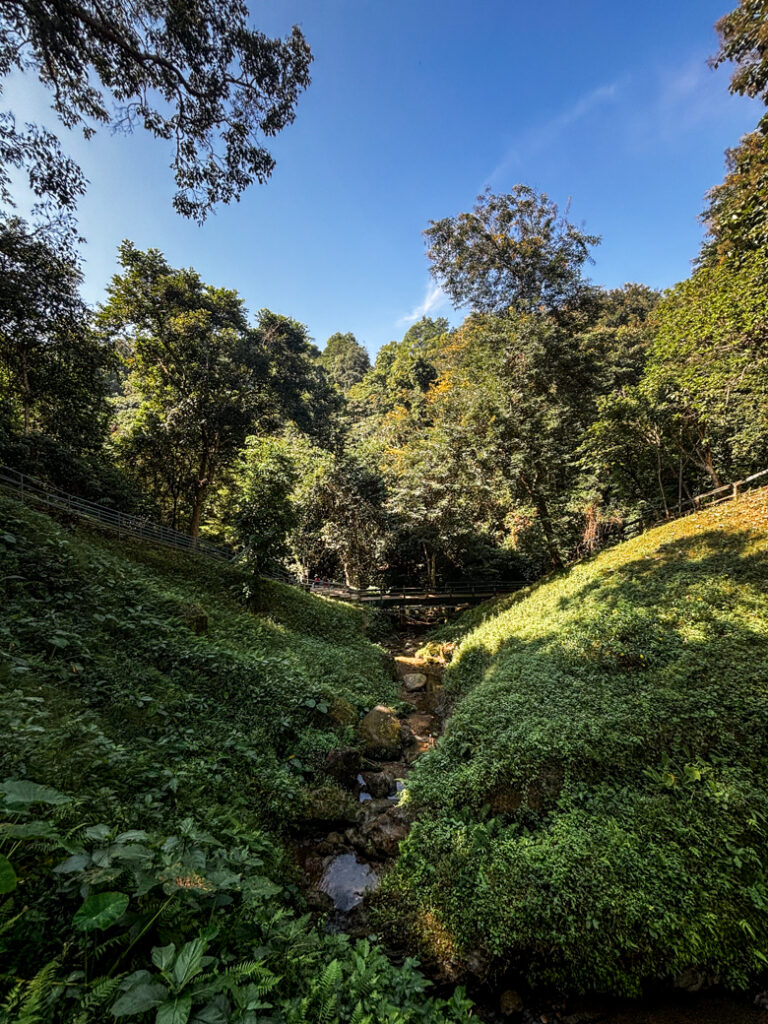
History of Unakoti:
Experts concur that Unakoti used to be a thriving Saivite pilgrimage in the past. Judging by the style of the rock sculptures, it perhaps dates back to the 8th – 9th century CE. They predate the Manikya rule in Tripura.
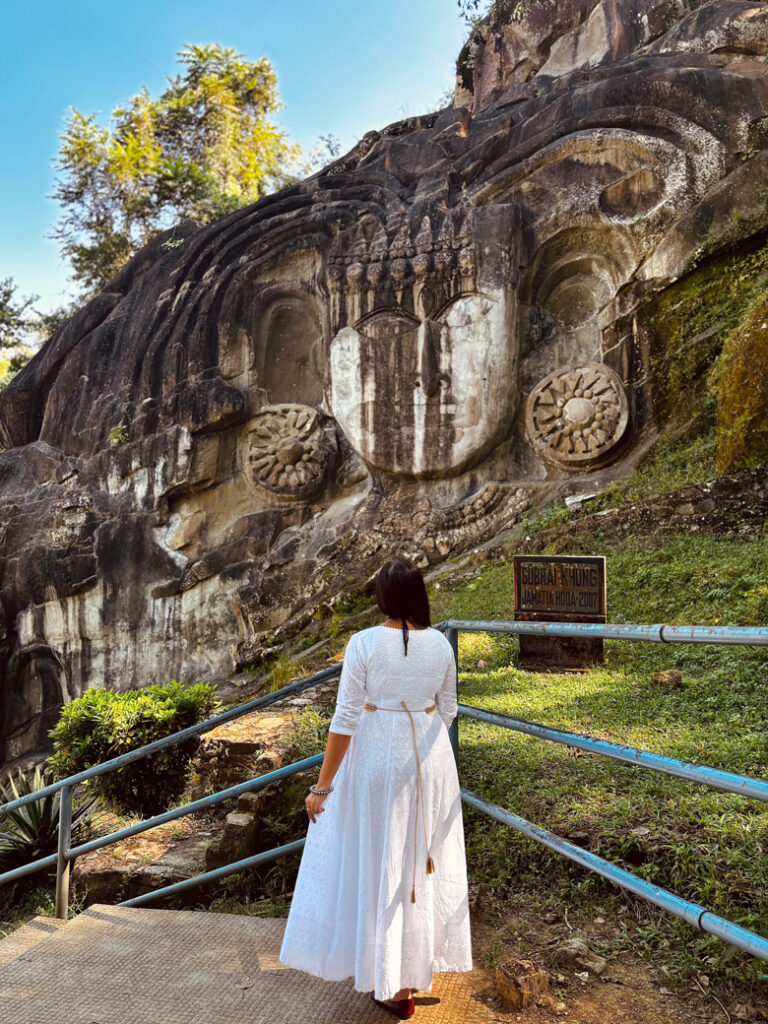
The earliest literary reference of this unique site is found in the writings of eminent scholar A.K. Chowdhuri as well as of Captain Williams, the then-British political agent to the royal court of Tripura. Later, Unakoti finds mentioned in the Annual Reports of the Archaeological Survey of India.
Legend of Unakoti:
In Bengali, ‘Unakoti’ literally translates to ‘one less than a crore’. In the local Kokborok language, it is called ‘Subrai Khung’. Like every other sacred centre of India, the origin of Unakoti can also be traced in the pages of mythology. The myth of Unakoti centres around Siva and his infamous rage. According to the legend, it was the meeting place of the 99,99,999 Gods and Goddesses along with Siva. They convened on the occasion of ‘Shukla Ashtami’ or the 8th day of the lunar fortnight of the Chaitra month with the intention of accompanying Siva on one of his trips to Kashi.

The entourage decided to take a rest and spent one night here. In turn, Siva explicitly directed them to wake up before dawn to resume their journey. However, only Siva was awake before sunrise while the rest of the retinue slept. Enraged by this disregard, Siva unleashed his fury, cursed them all to stone, and went on his way to Kashi alone. Thus, Unakoti became the abode of one less than a crore divine figures.

Another legend tells the tale of Kallu Kumhar, a brilliant artisan, who was a devout follower of Parvati. He requested the Goddess to allow him to accompany Her and Siva on their journey to Kailasa. In order to appease Siva, Parvati asked him to build one crore stone sculptures of Siva within a span of one night. Exceptionally skilled, Kallu Kumhar managed to carve almost one crore sculptures of Siva, failing short by one.

What to see here:
Unakoti is characterized by both colossal bas reliefs as also loose sculptures of various sizes. The most notable ones are:
The first base relief that steals attention is Siva as Gangadhara, which lies on the right of the entrance.

Siva is portrayed with ‘trinayana’ or three eyes, ‘jatabhara’ or matted locks cascading on both sides, a crown-like ornament adorning his forehead, and two ‘kundala’ or earrings.
Right next to the Gangadhara Siva, another huge relief of Siva is carved. It is characterized by ‘trinayana’ or three eyes, a grinning face, and a crown-like ornament covering the forehead.
Next comes the 30-foot-high Unakotisvara Kal Bhairava, the main deity of Unakoti who is still worshipped daily by the locals.

The iconographic features of this structure are akin to that of the Gangadhara Siva. The Kal Bhairava is flanked by Durga standing on a tiger/lion and Ganga with her ride, ‘makara’. Depictions of Nandi are also found nearby.
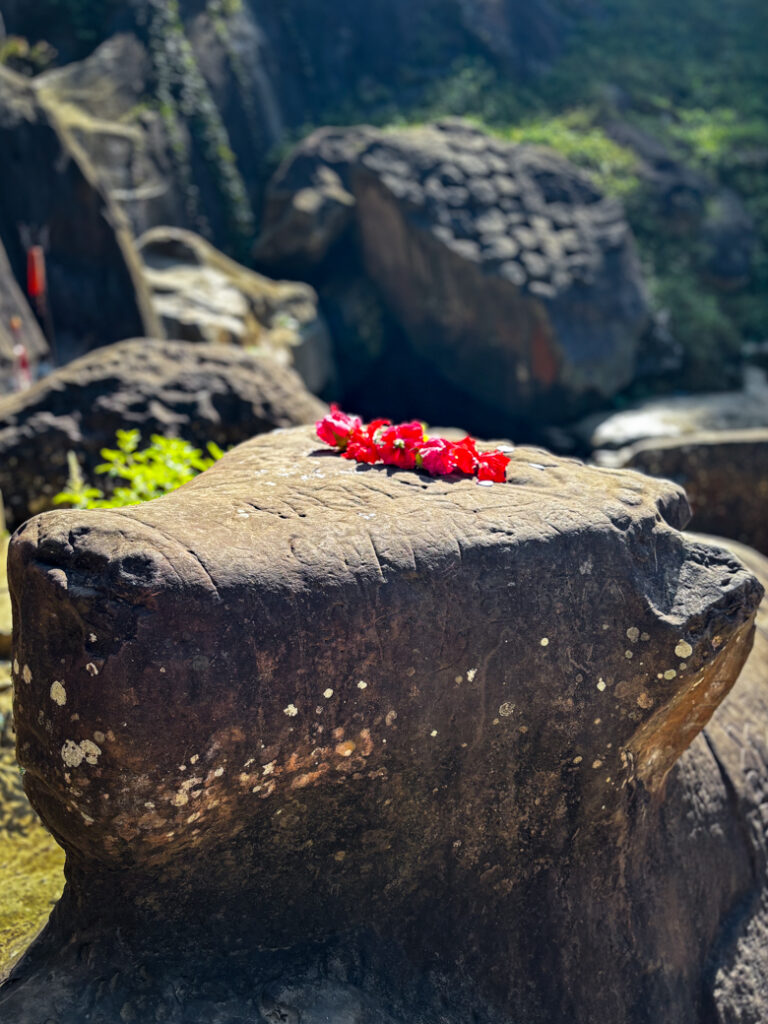
Close to the Unakotisvara relief, there lies a male figure with a bow and arrow accompanied by a female.
These images are believed to be Siva and Parvati disguised as Kirata and Kirati.
Above the Kirata figures lie the sculptures of Kamadeva aiming his arrow at Siva. This depicts the incineration of Kamadeva by the potent third eye of Siva.

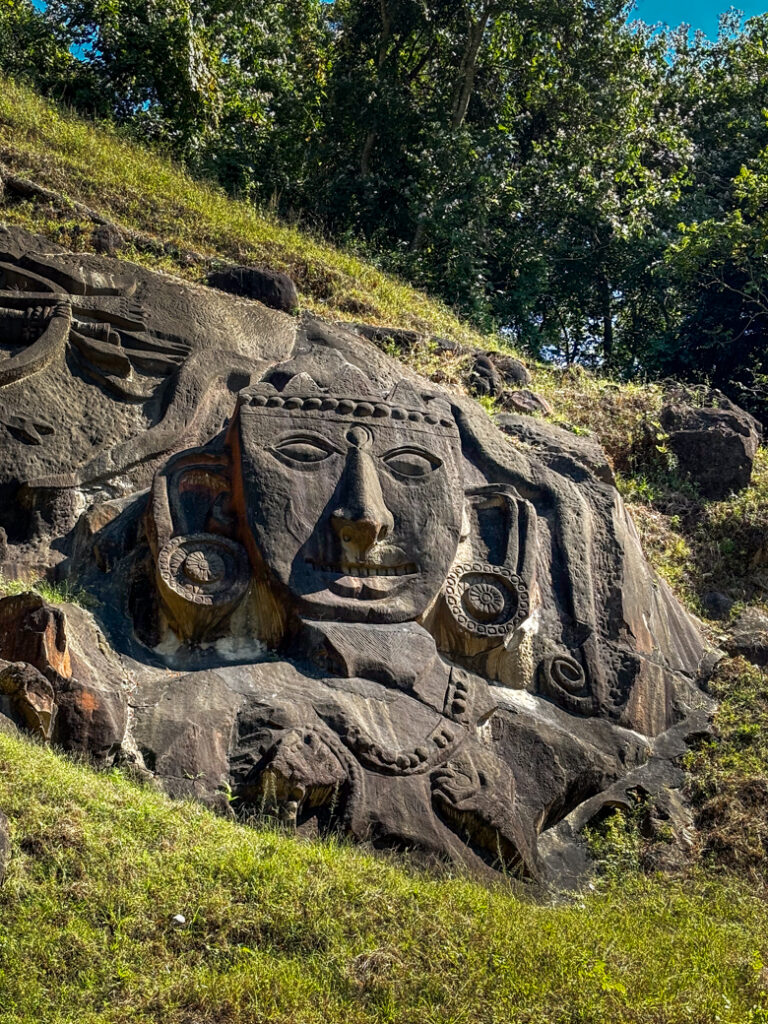
A little down the stream, there is a panel of three Ganesha reliefs with unusual characteristics.

The central seated Ganesha has a protruding belly, one tusk, and four hands. The standing elephant-headed deities on either side are characterized by attenuated waistlines, multiple tusks, and six and eight hands respectively.
In addition, the entire site is strewn with tattered sculptures of Uma–Mahesvara, Vishnu, Harihara, Narasimha, Hanuman, and so on.
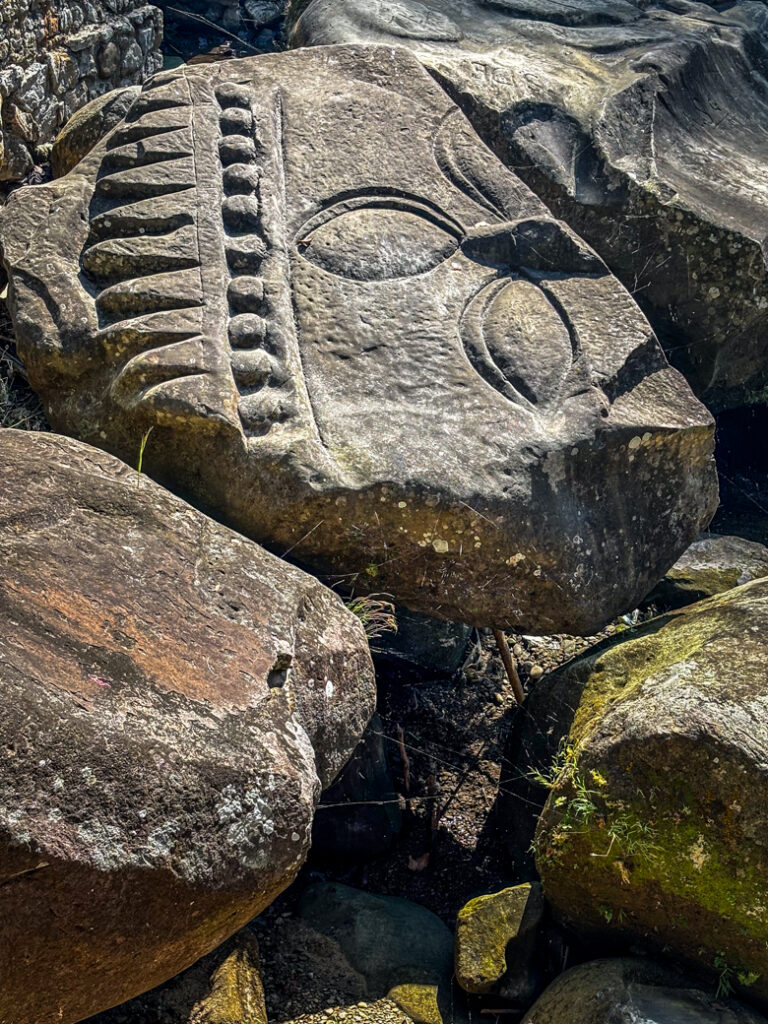
Important FAQs:
Where is Unakoti located?
It is located in the Kailashahar sub-division of Unakoti district in Tripura. It is 118 km from the capital Agartala, 47 km from Dharmanagar, 10 km from Kailashahar, and 22 km from Kumarghat.
How can I reach Unakoti?
By railway: The nearest rail station is Kumarghat. However, only passenger trains stop here. We suggest alighting at Dharmanagar where all trains, to and fro Agartala, give a stop. From Agartala, you can board 12097 Jan Shatabdi Express, 07679 Agartala – Karimganj DEMU Special, 15663 Silchar Express, 13174 Kanchanjangha Express, and 20501 Tejas Rajdhani Express.
From Dharmanagar, you will get ample shared jeeps to reach Unakoti. You can also hire a cab. It will cost you INR 1200 to 1500, depending upon your bargaining skills.
By road: As compared to trains, bus service is not quite reliable in Tripura. However, you can book a cab from Agartala for a day trip to Unakoti. The cab will charge around INR 5000.

What is the condition of the road for reaching Unakoti?
A year back, the road leading to the rock-cut sculptures was nothing short of a nightmare. The journey was simply hellish owing to potholes, loose rocks, and dust. But the scenario is now transformed altogether. The road has been widened and repaired, thus making the journey to Unakoti comfortable.
Where can I stay in Unakoti?
Unakoti itself does not have hotels. You need to stay either at Kailashahar or Dharmanagar. At Kailashahar, the only feasible option is Tripura Tourism’s Unakoti Tourist Lodge. By contrast, Dharmanagar offers more choices of accommodation, such as Lokenath Guest House, Hotel J C Plaza, Hotel Panchabati, and Hotel Unakoti. However, if you are visiting Dharmanagar during Kali Puja/Diwali, finding a room will be next to impossible. Dharmanagar is famous in Tripura for its outstanding Kali Puja. Therefore, tourists from all over the state pour into Dharmanagar making it difficult to get hotel rooms during this time. We, for example, could not find any room in Dharmanagar and had to make instant changes to our travel plans.
Is there any place to eat in Unakoti?
Apart from two shacks selling green coconuts, packaged mineral water, soft drinks, chips, cakes, and biscuits, you will find no restaurants here. For food, you have to rely on Kailashahar and Dharmanagar.
What is the entrance fee here?
Surprisingly, no tickets are required to enter this amazing place. You just have to enroll your name and a few details in a register at the gate.
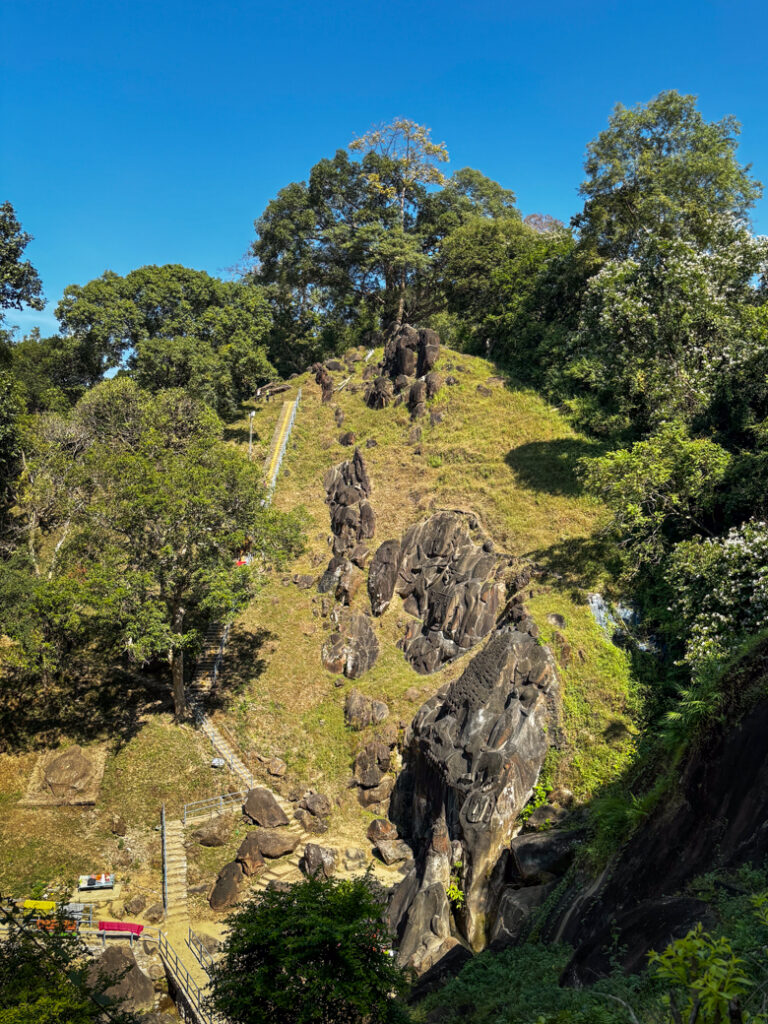
How to dress for visiting Unakoti?
There is no dress code here. However, since exploring this place involves a lot of walking and climbing the stairs, wear comfortable clothes and shoes.
What other points should I remember while taking a Unakoti tour?
A toilet facility is available for visitors here.
A baby care room is also at hand.
Even mobile charging points are also there!
Resting places with shades and benches are found all over the site.




what a beautiful discovery of a place! completely unheard of. lovely blog, great read.
Thank you so much for your kind words!